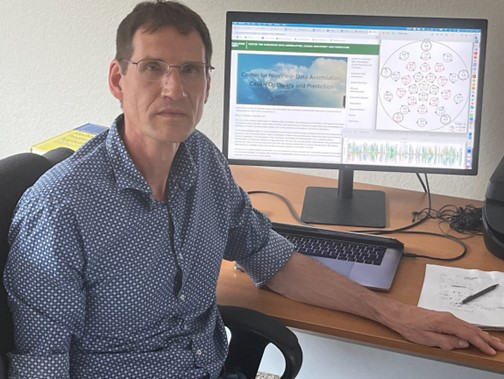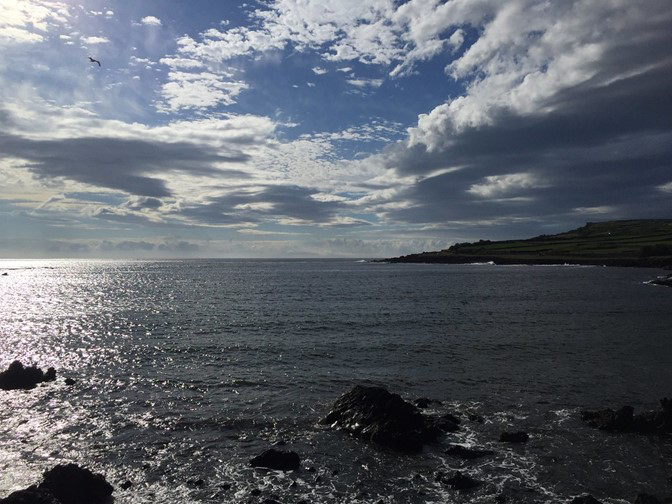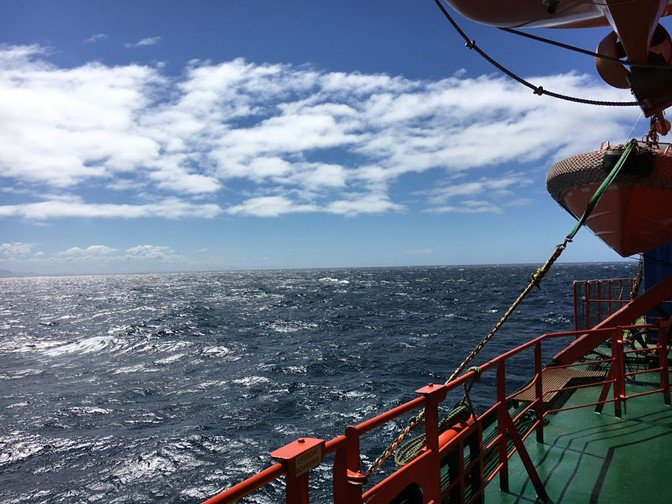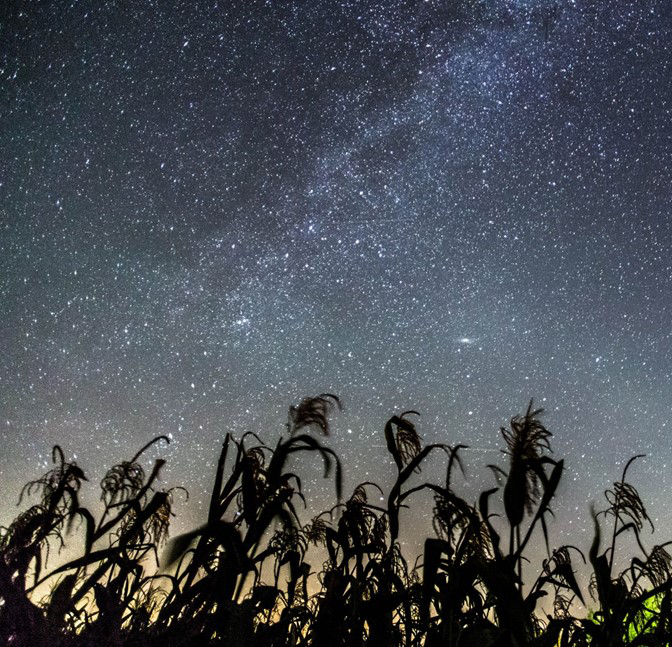A Colorado researcher leverages ASR funding in a search for the little-known causal pathways that link aerosols to cloud growth

As a boy in the Netherlands, Colorado State University atmospheric scientist Peter Jan van Leeuwen would often ride a bicycle from his home village of Voorhout to the North Sea coastline. Awaiting him, 30 minutes away, was a miniature of the natural world he fell in love with early in life—a place of “wind, waves, clouds, sand dunes and wildlife,” he says.
In school, Van Leeuwen (pronounced van LAY-when) excelled in mathematics and science classes, but “there was no real teaching about nature,” he says. “So, that’s what I did myself, with my friends.”
As a teenager, to learn even more, Van Leeuwen studied to be a certified nature guide along the same shoreline.
Today, Van Leeuwen is still a nature guide, of sorts. His research interests include ocean waves, hurricanes, and the microphysics of clouds—always with an eye to how advanced analysis methods can shed light on atmospheric processes.
Data Assimilation
These advanced methods include data assimilation, the science (and art) of combining numerical models with observations. Sometimes aided by machine learning, data assimilation continuously informs or refreshes predictive simulations of real-world conditions.
Van Leeuwen directs Colorado State’s Center for Nonlinear Data Assimilation, Causal Discovery and Prediction and is coauthor of Data Assimilation Fundamentals, a textbook.
He has written papers on data assimilation as applied to geosciences. Take, for instance, a 2022 study in JGR Atmospheres that examined the rapid intensification of tropical cyclones, a violently fast phenomenon that remains a significant predictive challenge in weather forecasts.
With Hurricane Patricia (2015) as a case study, he and his coauthors applied the ensemble Kalman filter (the EnKF), co-developed by Van Leeuwen, to analyze the dynamics and predictability of such intensification. The 2022 paper adds valuable details to what we know about the link between tropical cyclone evolution and vertical, horizonal, and radial wind structures.
The EnKF is a computational data assimilation technique that incorporates easy-to-compute “ensembles” of new-data updates. It streamlines the statistics of inferring the dynamics of nonlinear, spatially large systems with many variables, such as hurricanes. The EnKF updates the original Kalman filter, developed in 1960, whose algorithms make simulating high-dimensional systems computationally costly.
A Tangle of Interacting Variables

Lately, Van Leeuwen has a 2022-2025 project underway for the Atmospheric System Research program (ASR) at the U.S. Department of Energy (DOE). He is applying a mathematical framework that his group developed, which traces the pathways of how aerosols influence the evolution of clouds.
In the atmosphere, aerosols are suspensions of the tiny atmospheric particles that make clouds and precipitation possible. They have been widely studied, but little is known about the “causal pathways” they follow.
“To understand clouds means to understand the cause of why the cloud evolves as it does in a chain of causes and effects,” says Van Leeuwen.
For instance, more pollution could cause more aerosols to become cloud droplets, which in turn brightens the cloud. This causal pathway describes the progression from aerosols to cloud droplets to brightened clouds (which scatter more solar radiation back into space).
“Real causal pathways are much more complicated,” cautions Van Leeuwen, and they break the idea that relations between variables are linear. “There can be completely nonlinear relations,” which the new causal framework acknowledges.
In the atmosphere, causal pathways pivot on a tangle of interacting variables. These include how cloud water vapor condenses and evaporates, how cloud droplets grow by collision, and how cloud droplets become droplets of rain.
“There are many things working together,” he says.
Radiative Feedbacks

Once he has quantitative estimates of aerosol-cloud causal pathways in hand, Van Leeuwen says he will have a better grasp of which dominant atmospheric processes need to be included in models.
Van Leeuwen has a paper in progress on identifying the dominant processes, as well as non-dominant processes that might still be important.
“We are getting there,” he says of progress in the ASR work, “and we are getting there quickly.”
His research colleagues at Colorado State are veteran particulate matter researcher Sonia Kreidenweis (“a force of nature,” says Van Leeuwen), graduate research assistant Michael DeCaria, postdoc Ching-Shu Hung, and ARM data expert Christine Chiu. (Read her ASR scientist profile.)
This research addresses one of the greatest uncertainties in climate models, he says: how clouds influence the global energy budget with a cascade of radiative feedbacks.
Clouds occasion different radiative feedbacks. They can block solar radiation from the atmosphere, which has a cooling effect. Or they can absorb the radiation emitted from Earth’s surface, which has a warming effect because that emitted heat energy gets trapped in the atmosphere.
Help from ENA
Van Leeuwen has a special interest in the radiative effects of stratocumulus clouds in the marine boundary layer, with blanket-like effects that are “crucially important for the energy balance of the Earth,” he says.
For the ASR project, Van Leeuwen uses cloud and aerosol observations from the Eastern North Atlantic (ENA) atmospheric observatory on Graciosa Island in the Azores. It’s one of six observatories (three fixed and three mobile) operated by DOE’s Atmospheric Radiation Measurement (ARM) user facility.
“ENA is perfectly located,” says Van Leeuwen, since it features the right kind of clouds traveling over an island bristling with the right instruments: “radars, microwave radiometer, particle counters—you name it.”
Other measurements come from a 2017-2018 ARM field campaign called Aerosol and Cloud Experiments in the Eastern North Atlantic (ACE-ENA).
ACE-ENA data includes aircraft measurements from within clouds, which Van Leeuwen calls “extremely valuable.”
Little Aerosols, Big Role
Aerosols change cloud properties, giving them a significant role in determining cloud radiative effects.
Van Leeuwen explains the big role for little aerosols with this example: What if the cloud droplets created by aerosols are numerous, but very small?
So small, he says, “that none of them will become large enough to become a rain droplet. This would increase the lifetime of the cloud—in which case the cloud has a strong radiative effect.”
In nature, says Van Leeuwen, these effects are complicated by factors like temperature, humidity, and surface winds.
Such complications are what van Leeuwen hopes are represented in the coherent causal network he is developing. The aim is to create quantitative estimates—more exact than ever—on the interplay of aerosols, clouds, precipitation, and cloud radiative effects.
Research: Going Wide

Of course, a veteran researcher like Van Leeuwen has more than one iron in the fire.
In other work, he is investigating cloud aggregation—how smaller clouds merge into larger ones. He does this by studying how to couple easy-to-understand cloud box models, guided by observations, with large eddy simulation models.
Large eddy simulations model turbulence mathematically, in a way that is not too computationally expensive.
Van Leeuwen also investigates the connections between turbulent structures in hurricane boundary layers and hurricane intensification. (“We have some beautiful aircraft data” he says.)
Using high-resolution models in another project, Van Leeuwen is studying how small-scale layers of rain on the ocean surface influence the evolution of large-scale tropical circulation systems.
One such system is the Madden-Julian Oscillation (MJO), which transports water in climate-critical ways from the Indian to the Pacific to the Atlantic oceans.
Rain events create cold layers of fresh water on ocean surfaces, a phenomenon Van Leeuwen says is ubiquitous, little understood, but important.
Capping the ocean surface with cold layers inches to feet thick isolates heat stores until the layers are eroded by winds. Breaking the layers heats the atmosphere, creating strong updrafts that change ocean clouds.
In another research effort, using 30 years of ocean observations, Van Leeuwen’s team studies the interactions between the Indian and Atlantic oceans using ocean data assimilation and causal discovery.
And finally, on even larger scales, he is working to use data simulation to improve models used for subseasonal to decadal ocean-atmosphere predictions.
Van Leeuwen is broadly interested in analyzing the “highly nonlinear dynamics in the Earth system,” he says, which include “clouds, turbulent ocean dynamics, sea-ice dynamics, and ocean-atmosphere interactions at small scales.”
He is equally interested in what he calls the “techniques to study these systems better,” including data assimilation.
Getting to Science

“I have always been fascinated by the natural world, and how it works,” says Van Leeuwen, reflecting on his Dutch boyhood and the academic steps that followed. “Stars had my special interest, as well as Earthly nature.”
His parents helped, though neither had a university degree. Van Leeuwen’s father, who worked in the tulip bulb industry and then as a financial controller in a bank, was a whiz at calculus. His mother worked at a company selling academic books and journals, her own avenue to a kind of higher education.
Van Leeuwen is a first-generation university graduate, “but I never felt that way,” he says.
As an undergraduate at the nearby University of Leiden, he enrolled in the astrophysics program to satisfy an early fascination with stars, the night sky, and the constellations he learned to identify in his backyard.
But astrophysics wasn’t enough.
“I was just interested in everything,” says van Leeuwen, who eventually spent five years to earn three bachelor’s degrees in 1984: astrophysics, physics, and physics with chemistry.
However, “the stars won out” during a master’s program at the University of Amsterdam (M.S., theoretical physics, 1987), says Van Leeuwen. For the next two and a half years, he investigated the astrophysics of the first three minutes of the universe following the Big Bang.
He loved the mathematics, physics, and even the chemistry of that pursuit. But, in time, somehow theoretical physics “didn’t really work for me.”
And spending years to study a three-minute span of remote time based on speculation and indirect evidence, adds Van Leeuwen, “didn’t fit with reality.”
At Delft, Waves
What followed was a swerve back to the earthly realm, with doctoral work on coastal waves at Delft University of Technology in the Netherlands (PhD, fluid dynamics, 1992).
Van Leeuwen helped perform laboratory experiments, a first for him. He helped create ocean-like waves in a long flume with an artificial beach structure at the other end.
Delft also provided the only non-atmosphere field campaign of van Leeuwen’s science career, a jaunt with friends to Prince Edward Island in Canada to observe and measure storm-related nighttime waves.
His dissertation was on the generation process for low-frequency waves that never break on the coast but are nevertheless very important for sediment transport and coastal erosion—big concerns in a low-lying ocean-coast nation like his own.
“The funny thing is that the way we look at science is really great at explaining the world we see around us. But as soon as you get to the human being, science fails in every way, right?”
– Peter Jan van Leeuwen
“That’s where we had the Netherlands so interested in these kinds of waves,” says Van Leeuwen.
Data’s Siren Call
In those days, the general scarcity of ocean data led Van Leeuwen to data assimilation, which combines models with observations.
Those two sources of information, he says, deliver insights if used in a physically and mathematically consistent way.
Data assimilation was an art that Van Leeuwen practiced further through a postdoc and professorships at Utrecht University (1992 to 2009) and as director of the Data Assimilation Research Centre (DARC) at the University of Reading in the UK (2009 to 2019).
When Colorado State needed an expert in data assimilation, Van Leeuwen stepped across the pond.
He brought with him a continued interest in oceanography, hurricanes, air-sea interactions, and aerosol-cloud interactions. He also brought a knack for studying the work of atmospheric science colleagues and finding ways data assimilation can help.
Time On, Time Away
For years, Van Leeuwen has worked on his science even on weekends. “I love it,” he says. “It’s my hobby, too.”
But when there is time, he likes to set off on mountain hikes, travel to new cities, and read widely—books on geography, biography, the philosophy of science, and the guilty pleasure of science fiction.
“The funny thing is that the way we look at science is really great at explaining the world we see around us,” says Van Leeuwen. “But as soon as you get to the human being, science fails in every way, right?”
He asks: Where is the science of our inner lives? What is a thought? Or a feeling?
“There are things fundamental to our human experience that we just don’t know about,” says Van Leeuwen. “We try to measure things, but we walk around the human being. Science doesn’t touch it.”
# # #Author: Corydon Ireland, Staff Writer, Pacific Northwest National Laboratory
This work was supported by the U.S. Department of Energy’s Office of Science, through the Biological and Environmental Research program as part of the Atmospheric System Research program.

